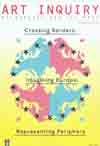Transcultural Congo as the Periphery of Europe or a Hybrid and Networked Archipelago: Transculturality within the Visual Culture Studies
Transcultural Congo as the Periphery of Europe or a Hybrid and Networked Archipelago: Transculturality within the Visual Culture Studies
Author(s): Konrad ChmieleckiSubject(s): Social Sciences
Published by: Łódzkie Towarzystwo Naukowe
Keywords: transculturality; Congo; imagining Europe; representing periphery; hybridity; networked archipelago; Visual Culture Studies
Summary/Abstract: The article takes up the issue of imagining and representing the periphery of Europe in the context of colonial and post-colonial reflection. The analyzed examples are art works that can be treated as transcultural representations. The main concept that has been scrutinized is transculturality as proposed by Wolfgang Welsch, who criticizes the existing concepts of individual cultures, as well as the ideas of multiculturalism and interculturalism. The starting point is the belief of Nicholas Mirzoeff that all cultures are transcultures. Within the field of Visual Culture Studies, the concept of transculturality has been replaced by transculturation and transculture, which are involved in the process of constructing networked cultural identities with a hybrid structure. The notions of transculturation and transculture can also be applied to the works of José Bedia. The evolution of Mirzoeff’s thinking about transculturality proceeds from the affirmation of the position of the Cuban anthropologist Alfonso Ortiz to the transformation of Welsch’s concept. The photographs of Herbert Lang are juxtaposed with the concept of “imperial transculture”, which refers to the scopic regimes of Martin Jay. These connotations also direct us toward the understanding of the concept of “imperialism” of Edward W. Said, who treats the Orient as an artificial construct. In this sense, one example of the operation of the visual regime of colonialization can be provided by the nkisi figures that appear in the works Fetish No. 2 (1988) by Renée Stout and Ta Tele (1988) by Trigo Piula, which can be interpreted in relation to Marcel Mauss’s magic fetishism and Karl Marx’s commodity fetishism. Another example of the operation of the visual regime of colonialization is the necropolitics of the civil war in Rwanda between the Hutu and Tutsi tribes and two more works – Scramble for Africa (2003) by Yinka Shonibare and The Chief: he who sold Africa to the colonists (1997) by Samuel Fosso. The concept of constructing an image of the Kongo peoples presented here is based on the assumption that it is the result of the operation of the discourse created by the European colonizers. This point of view can be also found in the book The Right to Look, where Mirzoeff constructs the definitions of visuality and countervisuality.
Journal: Art Inquiry
- Issue Year: 2013
- Issue No: 15
- Page Range: 9-30
- Page Count: 22
- Language: English

